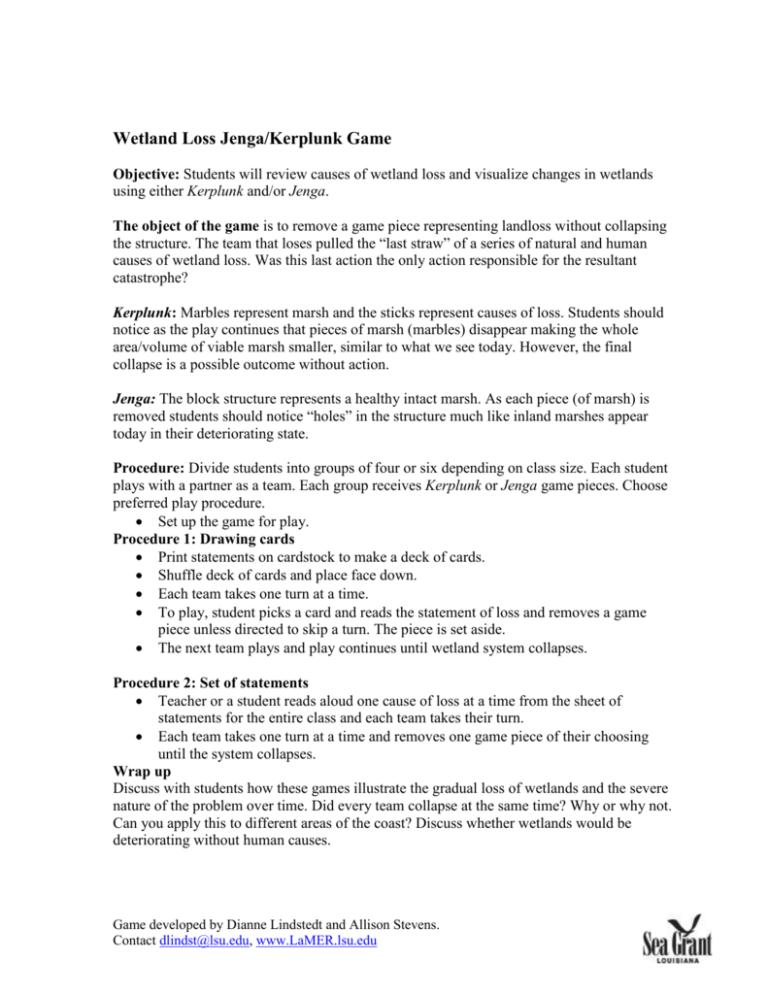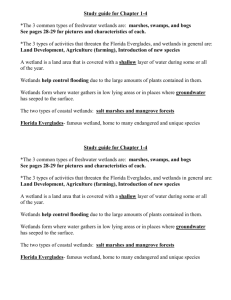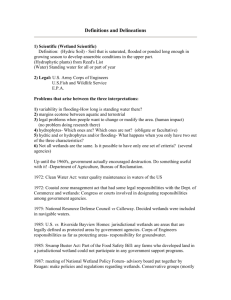Statements fpr Kerplunk land loss - ebrprofessionaldevelopmentportal
advertisement

Wetland Loss Jenga/Kerplunk Game Objective: Students will review causes of wetland loss and visualize changes in wetlands using either Kerplunk and/or Jenga. The object of the game is to remove a game piece representing landloss without collapsing the structure. The team that loses pulled the “last straw” of a series of natural and human causes of wetland loss. Was this last action the only action responsible for the resultant catastrophe? Kerplunk: Marbles represent marsh and the sticks represent causes of loss. Students should notice as the play continues that pieces of marsh (marbles) disappear making the whole area/volume of viable marsh smaller, similar to what we see today. However, the final collapse is a possible outcome without action. Jenga: The block structure represents a healthy intact marsh. As each piece (of marsh) is removed students should notice “holes” in the structure much like inland marshes appear today in their deteriorating state. Procedure: Divide students into groups of four or six depending on class size. Each student plays with a partner as a team. Each group receives Kerplunk or Jenga game pieces. Choose preferred play procedure. Set up the game for play. Procedure 1: Drawing cards Print statements on cardstock to make a deck of cards. Shuffle deck of cards and place face down. Each team takes one turn at a time. To play, student picks a card and reads the statement of loss and removes a game piece unless directed to skip a turn. The piece is set aside. The next team plays and play continues until wetland system collapses. Procedure 2: Set of statements Teacher or a student reads aloud one cause of loss at a time from the sheet of statements for the entire class and each team takes their turn. Each team takes one turn at a time and removes one game piece of their choosing until the system collapses. Wrap up Discuss with students how these games illustrate the gradual loss of wetlands and the severe nature of the problem over time. Did every team collapse at the same time? Why or why not. Can you apply this to different areas of the coast? Discuss whether wetlands would be deteriorating without human causes. Game developed by Dianne Lindstedt and Allison Stevens. Contact dlindst@lsu.edu, www.LaMER.lsu.edu Statements for Kerplunk/Jenga Wetland Loss Game Over the last 250 years Louisiana wetlands have been drained dredged, filled, leveed, leveled and flooded. Levees along the Mississippi River were built in earnest after the 1927 flood thus eliminating the periodic flooding of wetlands with freshwater and sediment that builds land in southeast Louisiana. Many petroleum industry canals are dredged during the 1950’s through the 1970’s for exploration and development of the resource. Navigation channels such as MRGO, Houma Navigation Canal and Barataria Waterway cut through Louisiana marshes having direct and indirect affects on wetland loss. Subsidence is a natural process in Louisiana wetlands. It is a part of the delta cycle. Hurricanes and storms may breach barrier islands decreasing protection of inland wetlands from waves and storm surge. Since they were built the levees along the Mississippi River deprive wetlands from receiving nourishing sediments and freshwater from the river every year. Nutria eat outs denude from 35,000 to 100,000 acres of marsh per year leaving these areas vulnerable to accelerated erosion, subsidence and scouring. Wetlands have been destroyed by converting them into dry land for agriculture. Barrier island projects widen and increase elevation of some barrier islands. Skip a turn. Over time sediments compact and the land subsides under its own weight thus decreasing wetland elevations. Without over bank flooding wetland elevations cannot keep up with the rate of subsidence. Between 1990 and 2000 wetlands loss in Louisiana was about 24 square miles per year. Global sea level is on the rise, threatening low lying areas with more frequent flooding. Wetlands have been drained and filled for coastal development such as camps, homes, businesses and industry. Over time boat wakes wash against spoil banks and natural waterways slowly eroding the edge. This process can cause canals to double in width within 20 years. Access canals for oil and gas development removes sediment, destroys wetlands where dredge material is deposited and changes overland flow. In Little Vermillion Bay hurricane flooding in 2005 from Katrina and Rita creates land at the Little Vermillion Sediment Trapping project. Skip a turn. Louisiana loses about one football field of wetlands every 38 minutes. Hurricanes and storms alter the shoreline decreasing protection of inland wetlands. Oil and gas canals with spoil banks can impound large areas of wetlands and cause either continuous flooding or no flooding. Dams and locks in the upper Mississippi River trap sediment thus reducing the sediment load that is transported to the lower river. From 1986-2006, 598 coastal restoration projects have been constructed in Louisiana wetlands. Skip a turn Game developed by Dianne Lindstedt and Allison Stevens. Contact dlindst@lsu.edu, www.LaMER.lsu.edu Hurricanes and storms can move inland sediments and may deposit it on the salt marsh surface. Louisiana marshes continue to be deprived of nourishing sediments since levees on the Mississippi River were built. Global warming of the Earth’s atmosphere may cause polar ice caps to melt causing increases in sea level rise worldwide. Dredging navigation channels removes sediment from wetlands, alters hydrology and allows salt water to be transported further up the estuary than previously. Natural subsidence rates increase when an area is not nourished by yearly influx of water and sediments. Hurricanes and storms can transform inland marshes to open water, breach barrier islands, and cause shoreline erosion. Spoil banks block natural flow of water and sediments over the marsh surface depriving them of water, nutrients and sediments. Wetland loss in Louisiana is caused by both natural and human induced activities. Dredge materials deposited on marshes buries them and destroys them. The Atchafalaya River Delta lobe is the only area where Louisiana wetlands are increasing in size. Skip a turn. The introduction of salt water into fresh and brackish wetlands through canals can weaken or kill local vegetation decreasing their ability to trap sediments and gradually transforming the area into open water. Hurricanes and storms may increase flooding and bring salt water further inland. During storms pounding waves erode mud and sand and currents carry sand and mud away from the shoreline. Dredging for navigation and oil and gas production destroys wetlands by removing land and creating open water. Hurricane Katrina negatively affected 217 square miles of wetlands in southeast Louisiana to open water. Scientists do not know if this is a permanent change in landscape. Oil and gas extraction practices can lead to additional local subsidence in an already naturally subsiding marsh. Spoil banks destroy marsh vegetation by converting them to higher drier land, thus disrupting hydrology and preventing over bank flow. The 76 mile long and 650 foot wide Mississippi River Gulf Outlet (MRGO) is completed in 1965. Today it is 1,500 feet wide. Game developed by Dianne Lindstedt and Allison Stevens. Contact dlindst@lsu.edu, www.LaMER.lsu.edu






